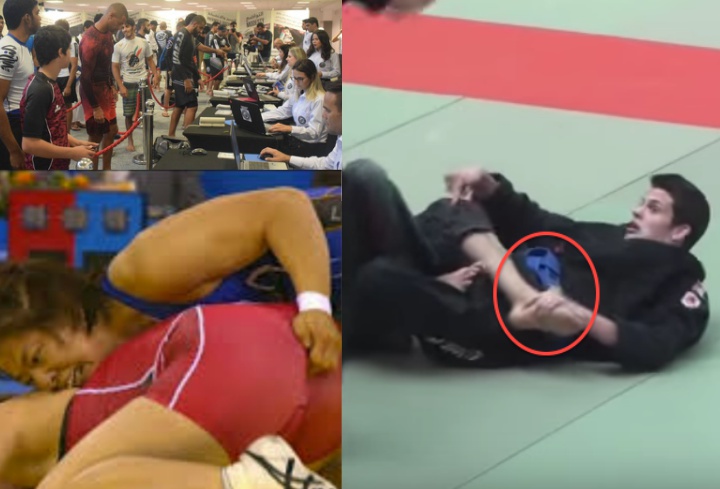Written by Raphaël Lévy of Jits.fr
In all games, sports or competitions in general, there are cheaters, those who seek by all means, to give themselves an unfair advantage over their opponents. BJJ unfortunately does not escape this rule. From the athlete who doesn’t just eat horse meat to the cheat who is fighting with lighter opponents, we’ll give you a brief summary of the most common ways of cheating that can be found in BJJ competition.
1 – Doping
Doping is the bane of any sporting competition. From the regional championship to the Olympic Games, it is found everywhere. Doping is the prohibited use of substances by sports organizations. They sometimes give superhuman powers (impressive development of muscular mass, cardio, endurance…) but also allow and especially to recover more quickly during and after the training, and therefore to train twice or three times as much. The disadvantage of these substances is that they are harmful to health: acne in the back, the shrinking of testicles to the size of raisins and heart attacks at 32 years of age, it’s no wonder that they are prohibited.
In 2014, after winning the IBJJF world Jiu-Jitsu championships, Felipe Pena faced a 1 year ban from USADA sanctioned competition for a positive result for testosterone. This was a victory for IBJJF, as it showed that the system worked. But does it really? The drug tests are announced months in advance and this means that athletes that are on gear can time their cycle so as not to get caught on a specific date. Did Pena simply time his cycle wrong? How many more athletes are cheating their way to victory by timing their PED use?
Drug testing is very expensive and IBJJF is doing the right by testing it’s athletes but is it really enough?
Without unannounced, random PED tests, there is zero chance of catching PED abusers. The biggest advantage of steroids is the ability it gives a person to recover. In BJJ the users will be able to train longer, harder than a natural competitor, then just stop taking a month prior to competition so they too can piss clean. They’ll be able to work on rolling and technique much more than a natty competitor for most of the year. Even if they lose strength gains from coming off a steroid cycle, they will not lose the advancements they made on technique.
This fitness expert explains exactly why this type of drug testing is ineffective and how the athletes are able to beat it:
2 – Cheating at Weigh-ins
One way of cheating in a BJJ competition can be done when the competitor is not really known by tge organizers and other competitors. It consists of asking someone much lighter who looks like you to weigh in for you in a lighter weight class then your usual one….By doing so, the cheater can face opponents that are from 5 to 15 kgs lighter. This can only be done in competitions that weigh-ins in the morning or the day before. This would be be almost impossible in IBJJF where they check everything before your first match. This is very dirty and unsportsmanlike strategy that unfortunately has been used on many occasions. Another way is to weigh yourself without the belt (if weigh in is done with the Gi) as the Gi checker will sometimes forget to check and a belt is usually 200 to 300 grams.
3 – Sandbagging
Sandbagging is a term used in martial arts to denote a practitioner who competes at a skill-bracket deemed less rigorous than their actual level of competitive ability. The term is adopted similarly in golf and various forms of racing. In contrast to these sports however, it remains unclear whether the grappling “sandbagger” necessarily does so intentionally. For example, in Judo or Brazilian Jiu-Jitsu, where competition is generally divided by belt rank, a practitioner is conventionally not allowed to choose his or her own ranking and thus must compete at a level predetermined by his or her instructor.
4 – Fake Tap
Fake Tap is the act of tapping out just once, or tapping discretely out of the referee’s field of vision, in order to get out of a submission (so the opponent lets go of the hold) and then carrying on fighting and hoping to continue the fight and win.
It is a subtle form of cheating and is frowned upon within the MMA and BJJ communities.
In the UFC championship fight between Murilo Bustamante and Matt Lindland, Bustamante was the one who was a victim of the Brazilian tap. The Brazilian jiu-jitsu veteran first locked in a submission on Matt Lindland and while it appeared he tapped out, causing the referee to stop the action, Lindland protested the call before it was decided to restart the fight! Bustamante, ended up finishing the fight in round 3 with a guillotine choke in the third round.
In BJJ the fake tap is an old trick. One way of doing it is to discretely tap under your opponent’s Gi jacket so that they let go of the submission.
A brilliant example of an evolved fake tap in BJJ, using amazing trickery:
5- The sneaky cheater
This is the guy who will do grimey stuff like stick a finger in the eye, and be like oops, not on purpose. If the referee does not see it, it’s jackpot.
Thanks to the modification of the rules, some no longer exist. The best known being certainly to pass the opponent’s foot over the hip and scream for a disqualification. For the past few years, there has been no disqualification but it has been put back in the initial position (or disqualification of the player who voluntarily displaced the opponent’s foot).
Be aware that doing this may lead to disqualification and license suspension depending on the federation in which we are evolving (and the seriousness of the fault).
In this example, from a France championship few years ago. Starting at 1:15 the cheater purposely put his opponent’s leg on prohibited knee reaping position, showed it to judge and got his opponent disqualified.
6- Handshake Takedown
When a competitor ignores a handshake and shoots instead for a takedown which can get you 2 points. It’s legal but very poor sportsmanship.

















